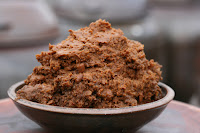Korean Food & Fermentation
Posted by Admin
on Saturday, April 7, 2012
0
One of the most interesting characteristics about Korean food is that the preparation of it often involves the process of fermentation. Fermentation was frequently utilized by enlightened spiritual practitioners of ancient Korea to create food that would benefit all people. In the old days, fermented food such as soy sauce (Ganjang 간장), bean paste (Doenjang 된장), and Korean chili pepper paste (Gochujang 고추장 ) were important source of protein for Koreans, and they remain popular to this day. Of course, no Korean meal would be complete without the ubiquitous Kimchi, a fermented vegetable dish. Traditionally, fresh vegetables were scarce in winter. Kimchi, therefore, was the main source of vitamins for Koreans in wintertime.
Recently, the Health magazine announced the five best health foods in the world, and they included Greek yogurt, Spanish olive oil, Japanese natto, Indian lentils, and Korean Kimchi. It is interesting to note that the three out of five healthiest foods are prepared through the process of fermentation. It begs the question: why is fermented food good for health? The process of fermentation brings about interesting changes to the flavor and texture of the food. More importantly, however, when food is fermented, it encourages the growth of healthy bacteria while preventing the growth of spoilage-causing bacteria. Doing this successfully requires special ingredients and carefully controlled conditions such as temperature and pH.
Recently, the Health magazine announced the five best health foods in the world, and they included Greek yogurt, Spanish olive oil, Japanese natto, Indian lentils, and Korean Kimchi. It is interesting to note that the three out of five healthiest foods are prepared through the process of fermentation. It begs the question: why is fermented food good for health? The process of fermentation brings about interesting changes to the flavor and texture of the food. More importantly, however, when food is fermented, it encourages the growth of healthy bacteria while preventing the growth of spoilage-causing bacteria. Doing this successfully requires special ingredients and carefully controlled conditions such as temperature and pH.
 About the Author
About the Author
Write admin description here..
Get Updates
Subscribe to our e-mail newsletter to receive updates.
Share This Post
Related posts









0 comments: